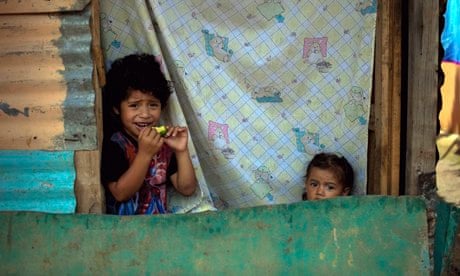It is a big day for the small picturesque village of Pamumus in the mountains outside of Guatemala City. The vice-president, Roxana Baldetti, is coming to visit.
Villagers from all around, mostly the indigenous Kaqchikel people, have turned up in their finest outfits. Blue-and-white bunting adorns the small square filled with white plastic chairs; outside the school, boys play a marimba – a form of xylophone – and a tortuga instrument made from tortoise shells. Women wearing colourful beaded jackets sell corn on the cob and trinkets, while small children wave blue balloons.
The lush maize-covered slopes around Pamumus – which means "heavy drizzle" in the Kaqchikel language – and views of distant volcanoes give an impression of agricultural abundance. But appearances are deceptive in a region hard hit by Guatemala's 36-year civil war that ended in 1996.
The department of Chimaltenango, which includes Pamumus, has a chronic child undernourishment rate of 61.2%. According to the World Bank, Guatemala has the third-highest rate of chronic malnutrition, or stunted growth, (54%), and, says the EU, the country loses more than $300m (£186m) in GDP every year to vitamin and mineral deficiencies.
Reducing malnutrition is a priority for the government. When President Otto Pérez Molina appeared at the UN general assembly in New York last month, he spoke about his government's efforts to reduce hunger.
The centrepiece of Guatemala's struggle against undernourishment is its zero-hunger plan that aims to reduce chronic malnutrition in under-fives by 10% by 2016. At the UN, Pérez, a former military man, said Guatemala's efforts were progressing as it had cut infant mortality from undernourishment by 50%.
The government has won recognition from international development experts. Guatemala came first last year in the Hanci global hunger index that ranked 44 countries on their hunger and nutrition commitment. The zero-hunger plan was one of the reasons, along with substantial investment in health and having a separate nutrition budget line to make its spending accountable to all, for Guatemala's top ranking.
In Pamumus, Linda Johana has not heard of the zero-hunger plan, but says there have been fewer deaths from child malnutrition in recent years, probably because of a more diverse diet. "We are eating lettuce, tomatoes and corn," she says. "The school feeding programme gives children better snacks: radishes, potatoes, cucumber and fruit."
As for the plentiful field of maize, with stalks climbing to three metres, she says much of the land is owned by those lower down the mountain. "They own lots of land and sell the maize to others," she says, alluding to this politically sensitive subject and a key factor behind the civil war.
Guatemala has one of the world's highest rates of land concentration, where 3% of private landowners occupy 65% of the arable land, producing coffee, sugar cane and bananas for export. Small farms (fewer than four hectares) occupy only 11% of agricultural land.
Although things are getting better in Pamumus, life remains hard, especially when illness strikes. Paula, who would rather not give her full name, describes how expensive it is to keep four children in school. Things became particularly difficult when one of them fell ill and they had to go to hospital in Guatemala City, some 22 miles away.
"Life's got harder because the children are at school, which takes a lot of money, and two years ago we had to travel to the city because the doctors here did not know what the problem was," she says. The family eats beans and tortilla all week, except for Tuesday, when Paula buys eggs or a chicken from the local market.
Arnulfo Alvarez, the only doctor in the area, confirms how hard life is in the village. Sixty-seven of the 112 under-fives in Pamumus suffer from chronic malnutrition. Villagers live in remote locations and a lack of money means they live mostly on corn and beans, a diet low in protein. Children receive cereal and food supplements – iron, zinc and folic acid – and mothers are being encouraged to breastfeed their babies for the first 12 months.
The excitement in the village builds as Baldetti arrives by helicopter. She makes a beeline for the cutest children before working the crowd. At one point she asks: "Does your husband beat you? Because if he does, I want you to let me know."
She has flown to Pamumus mainly to show her appreciation to the European Union for providing aid to Guatemala. Andris Piebalgs, EU development commissioner, is visiting the village as part of a Latin American tour.
Last week, the EU announced it would provide up to €775m (£653m) for bilateral assistance to Nicaragua, El Salvador, Guatemala and Honduras between 2014-20, subject to approval by the European council of government leaders and the European parliament. Guatemala is expected to get €186m, which will be channelled through the government.
"What you can achieve for €20-25m per year in aid here can be very dramatic," says Piebalgs. "We can really do something here, be a game-changer in areas like nutrition."
The question, as ever, is whether the aid will get through to those who need it most. EU officials believe the Pérez government means what it says on hunger and malnutrition. "This government wants to look good and that is already something," a senior official says.
Mark Tran travelled to Guatemala with the European commission

Comments (…)
Sign in or create your Guardian account to join the discussion